- Share full article
Advertisement
Supported by
RAID ON IRAQ

RAID ON IRAQ; The Day's Weapon of Choice, the Cruise Missile, Is Valued for Its Accuracy
By Eric Schmitt
- Jan. 18, 1993
The military relied on unmanned Tomahawk cruise missiles in today's attack on Iraq because of the missile's accuracy and to avoid sending piloted aircraft near heavily defended Baghdad.
About 40 cruise missiles, carrying 984-pound explosive warheads, were fired at what United States officials said was the Zaafaraniya nuclear fabrication plant from four ships in the northern Persian Gulf and Red Sea, Pentagon officials said. Senior Defense Department officials said they would have to wait for reconnaissance reports overnight before judging the mission's success.
Iraq said today that one of the cruise missiles had struck the Rashid Hotel in downtown Baghdad. A senior Pentagon official said he could not "rule out" the possibility that a Tomahawk was shot down over the city and crashed into the hotel, but he said he "seriously doubted it."
One senior Pentagon official said, however, that Navy targeters had routed some of the missiles over an area near the the Rashid Hotel. The Tomahawk's radar guidance system navigates by matching up physical contours against a programmed digital map in its memory. Once near its target, an optical sensor takes over. 'Perfect Candidate'
A senior Defense Department official said the Iraqi plant was "a perfect candidate for a strike by cruise missiles because of the need for pinpoint accuracy and because Baghdad is so heavily defended." During the Persian Gulf war, the Navy fired 288 cruise missiles from 16 ships and 2 submarines, mainly against high-priority targets in Baghdad, including headquarters buildings and power plants. The Navy has said that 85 percent of the low-flying drones were successful.
The military sent only Tomahawks and F-117 Stealth fighters inside Baghdad city limits during the gulf war. Eighty percent of the Tomahawks were fired during the day, while the F-117's bombed by night. Baghdad is the most heavily defended city in Iraq, ringed by batteries of SA-3 and SA-2 missiles and antiaircraft guns.
Tomahawks, which cost about $1 million apiece, freed up manned aircraft to carry out other bombing missions, and were effective in poor weather that hampered the use of precision-guided weapons dropped by airplanes. In the first 24 hours of the gulf war, the Navy fired 116 of the 288 Tomahawks used in the conflict.
Cruise missiles, however, pack less of a punch that the 2,000-pound bombs that were staples of Air Force fighter bombers against hardened targets in the gulf war. Tomahawks, which need to fly over terrain with distinct contours, fare poorly over featureless deserts. Four Shipes Fired Missiles
In today's attack, about 40 Tomahawks were fired from four ships. Three ships -- the Aegis cruiser Cowpens and two Spruance-class destroyers, the Hewitt and the William H. Stump -- were in the northern Persian Gulf, about 450 miles from the target. Another ship -- the Spruance-class destroyer Caron -- was in the northern Red Sea, about 700 miles from the target.
A Pentagon official said that one or two missiles may have malfunctioned soon after being launched, but that the rest appeared to have struck the target, eight miles southeast of Baghdad.
An attack submarine capable of firing cruise missiles, the Louisville, was sailing just outside the Strait of Hormuz today, but did not join the attack, Pentagon officials said. Conventional Warheads Used
The Tomahawk attack started shortly after noon Eastern time today, and the missiles took 60 to 90 minutes to strike their targets, Navy officials said. The cruise missiles are made by the McDonnell-Douglas Corporation and the Convair division of the General Dynamics Corporation.
Cruise missiles, which are about 21 feet long and travel about 550 miles an hour, have a range of about 700 miles when equipped with conventional warheads. The missiles use three warheads: the conventional explosive, incendiary bomblets, and a top-secret warhead filled with carbon filaments designed to short-circuit electrical power grids. Today's attack apparently used only the conventional explosives.
Typically flying 50 to 100 feet above the ground to avoid radar detection, the Tomahawks rely on tracking terrain contours programmed in its guidance system to guide it to the target. In the gulf war, Tomahawks fired from the submarine Pittsburgh in the eastern Mediterranean Sea were routed north through Turkey because of high-relief terrain.
The commander of naval forces during the gulf war, Adm. Stanley R. Arthur, who is now Vice Chairman of Naval Operations, said in an interview shortly after the end of the war, "If the Tomahawk gets in the air and flies, with no wing or booster failures, we knew the missile had good arrival-on-target."
Air strike numbers
Allies expanding southern "no-fly zone", iraqi troop movement.
Saddam denounces attack as 'criminal'
WASHINGTON (CNN) -- U.S. and coalition forces launched missiles and bombs at targets in Iraq as Thursday morning dawned in Baghdad, including a "decapitation attack" aimed at Iraqi President Saddam Hussein and other top members of the country's leadership.
President Bush announced the start of the military campaign against Iraq shortly afterward in a televised address from the White House.
"American and coalition forces are in the early stages of military operations to disarm Iraq, to free its people and to defend the world from grave danger," Bush said. ( Full story )
Administration sources said the decision to strike came after a nearly four-hour meeting in the Oval Office in which CIA Director George Tenet and Pentagon officials told Bush they could lose the "target of opportunity" if they didn't act quickly; Bush then gave the green light.
Hours later, a defiant Saddam wearing a military uniform appeared on Iraqi television to denounce the U.S.-led military campaign as "criminal" and to say his countrymen would be victorious.
"We pledge that we will confront the invaders," he said, adding Iraqi resistance would cause the coalition to "lose any hope in accomplishing what they were driven to by the criminal Zionists and others with their agendas."
In his taped speech, Saddam gave Thursday's date, March 20, as a sign it was recorded after the coalition attack. He ended his message by saying, "Long live jihad and long live Palestine." ( Full story )
In New York, Iraq Ambassador to the United Nations Mohammed Aldouri said, "It seems that the war of aggression against my country has started."
He called the the military action "a violation of international law" and said he would ask the United Nations and the Security Council Thursday to hold allied forces accountable for the attacks on Iraq.
More than 40 satellite-guided Tomahawk cruise missiles were fired from U.S. warships in the Red Sea and Persian Gulf, military officials said. F117 stealth fighters , which carry two 2,000-pound bombs apiece, also were involved in the strikes, though apparently on a target other than Saddam.
Air raid sirens were heard in Baghdad at about 5:30 a.m. Thursday (9:30 p.m. Wednesday ET) about 90 minutes after the U.S. deadline for Saddam to step down or face a U.S.-led military attack.
In his four-minute announcement from the Oval Office, Bush said the military campaign, supported by 35 nations, would make efforts to spare Iraqi civilians. But he made it clear the U.S. military planned to use its full might in the war.
"This will not be a campaign of half measures, and we will accept no outcome except victory," he said.
The president's address came at 10:15 p.m., about two hours and 15 minutes after the expiration of the deadline. ( Transcript )
The United States and Britain have massed nearly 300,000 troops in the Persian Gulf region.
In other developments:
• An early morning Iraqi radio message from a representative of Saddam Hussein's eldest son, Uday, said: "God protect us from foreign aggressors. God give us patience. God protect our leader."
• Seventeen Iraqi soldiers surrendered to U.S. troops Wednesday. They were believed to be the first of their countrymen to give up -- a move the U.S. Air Force has been actively encouraging by showering the Iraqi landscape with more than 2 million leaflets in anticipation of a ground war. ( Full story )
• Iraq is unlikely to use chemical or biological weapons to defend itself from a U.S.-led invasion because world opinion would turn against it, chief U.N. weapons inspector Hans Blix said Wednesday. "Saddam Hussein has certainly figured himself to be a sort of emperor of Mesopotamia, and the leader of the Arab world," Blix said. "So I think he very likely cares very much about his reputation." ( Full story )
• The king of the Persian Gulf country of Bahrain offered "safe exile" to Saddam, saying he hopes the Iraqi leader "would seriously consider this offer before the onset of war," the government-run Bahrain News Agency said Wednesday. ( Full story )
• Egyptian President Hosni Mubarak said Iraq is fully responsible for the current crisis in the Middle East, the Kuwait News Agency said.
• Chaos at the Kuwait City International Airport early Thursday led officials there to close roads into the airport and allow in only employees and ticket-holders, officials said. They also said they would not let anyone else in until the situation calmed down. Video footage of the airport terminal showed it packed with people, and crowds pushed up against ticket counters.
• Bush notified Congress on Wednesday he has made a determination that diplomacy will not work to disarm Saddam -- a condition required under a resolution approved by lawmakers in October authorizing the use of force against Iraq. ( Bush's day , text of Bush letter to Congress )
• Kurds in northern Iraq were fleeing towns and retreating to mountain areas in anticipation of war, and in the southern region dozens of Iraqi dhows were moving through the Straits of Hormuz and out of the Persian Gulf. Baghdad residents have started fleeing the capital. ( Mood in Baghdad )
• Turkey's parliament is expected to vote Thursday on the government's request to allow U.S. warplanes to fly over Turkey. But the government will not seek a vote on a U.S. request to use Turkish bases for about 62,000 troops to move against Iraq from the north.
• Both houses of Italy's parliament Wednesday authorized the government to offer the U.S.-led coalition use of Italian air space and military bases in a conflict with Iraq, but the approval did not include allowing departure points for direct attacks. ( Full story )
CNN correspondents Ryan Chilcote, John King and Barbara Starr contributed to this report. For latest developments, see CNN.com's Iraq Tracker.
EDITOR'S NOTE: CNN's policy is to not report information that puts operational security at risk.
Official websites use .gov
Secure .gov websites use HTTPS
Snapshots of what’s happening in the Defense Department.
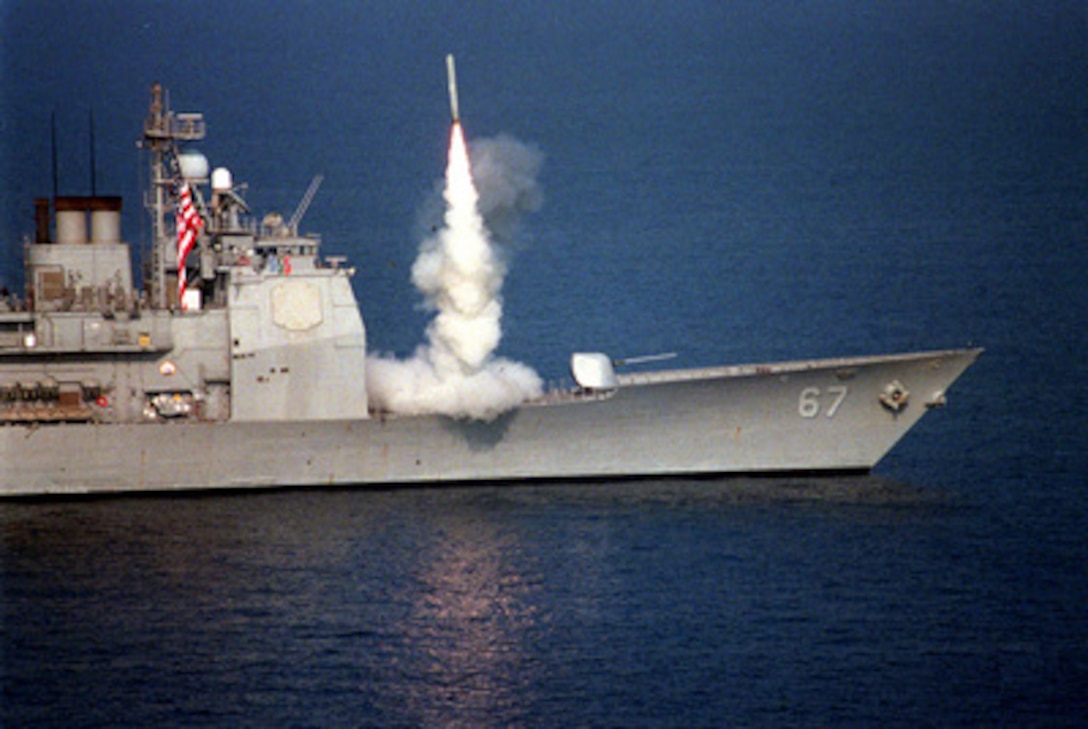
USS Shiloh (CG 67) launches a Tomahawk cruise missile against Iraq.
A Tomahawk cruise missile launches from the forward vertical launch system of the USS Shiloh (CG 67) to attack selected air defense targets south of the 33rd parallel in Iraq on Sept. 3, 1996, as part of Operation Desert Strike. The attacks are designed to reduce risks to the pilots who will enforce the expanded no-fly zone. President Clinton announced an expanded no-fly zone in response to an Iraqi attack against a Kurdish faction. The larger no-fly zone in Southern Iraq will make it easier for U.S. and coalition partners to contain Saddam Hussein's aggression. The U.S. Navy Ticonderoga Class cruiser launched the missiles as it operated in the Persian Gulf.
- Download Image: Full Size (0.06 MB)
- Photo By: VIRIN: 552291-F-NUT17-441.jpg
Defense.gov
Helpful links.
- Live Events
- Today in DOD
- For the Media
- DOD Resources
- DOD Social Media Policy
- Help Center
- DOD / Military Websites
- Agency Financial Report
- Value of Service
- Taking Care of Our People
- FY 2025 Defense Budget
- National Defense Strategy
The Department of Defense provides the military forces needed to deter war and ensure our nation's security.
- Arab-Israeli Relations
- Proliferation
- Palestinians
- Gulf States
Regions & Countries
- Middle East
- North Africa
- Arab & Islamic Politics
- Democracy & Reform
- Energy & Economics
- Great Power Competition
- Gulf & Energy Policy
- Military & Security
- Peace Process
- U.S. Policy
- Policy Analysis
- PolicyWatch 3732
U.S. Deploys Cruise Missile Submarine to Strengthen Deterrence Against Iran
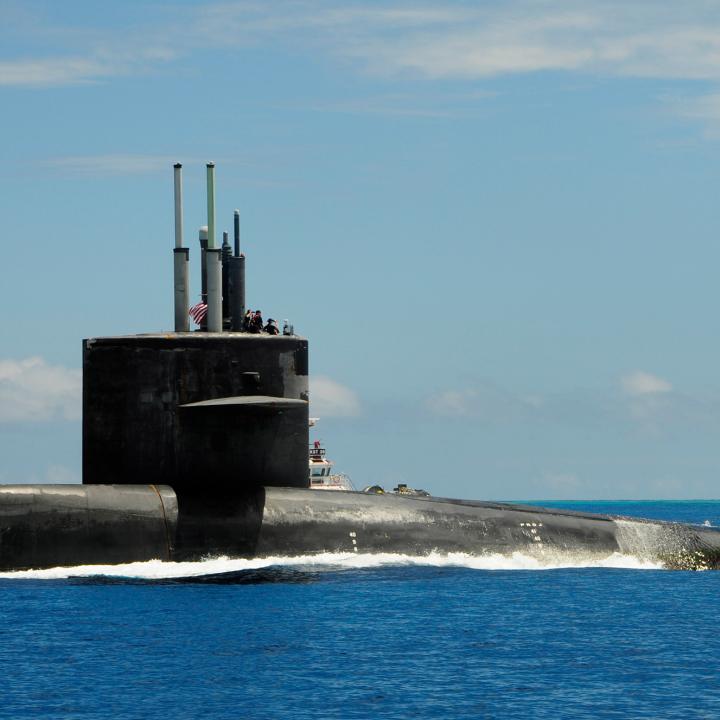
Farzin Nadimi, a Senior Fellow with The Washington Institute, is a Washington-based analyst specializing in the security and defense affairs of Iran and the Persian Gulf region.
Amid rising tensions with Tehran and its proxies, the United States is sending a message by openly deploying one of its few guided missile submarines to the region.
Typically, U.S. submarine deployments are not announced in advance, especially when the vessels are entering a potentially hot zone of operation that may require them to rely on stealth, their main operational advantage. Yet conventionally armed guided missile submarines are an exception—their presence is occasionally made known as a show of deterrence. This seemed to be the main purpose when U.S. Naval Forces Central Command announced on April 8 that the USS Florida (SSGN-728) had been deployed to the Middle East “to help ensure regional maritime security and stability.” The Florida is one of only four guided missile/special forces submarines in U.S. Navy service—vessels that are usually tasked with top-priority clandestine missions.
Increased U.S.-Iran-Israel Clashes
On March 23, a U.S.-manned forward base near Hasaka, Syria, was attacked by an explosive drone launched by Iraqi Shia militias affiliated with Iran’s Islamic Revolutionary Guard Corps (IRGC). Among other casualties, an American contractor was killed in the attack—an outcome that crossed Washington’s red lines and triggered multiple U.S. airstrikes inside Syria. Yet those strikes were only partially successful in deterring Iran and its proxies—a salvo of rockets was soon fired at another U.S. compound in Syria, raising concerns about further escalation.
These clashes coincided with a series of Israeli standoff precision airstrikes against IRGC and Hezbollah targets in Syria beginning on March 30. The resultant deaths of two IRGC officers and other operatives prompted Tehran to issue promises of revenge. On April 2, a drone of reportedly Iranian origin tried to penetrate northern Israel from Syria but was shot down. The next day, Israel downed a Hamas Shahab drone as it tried to enter from the Gaza Strip.
Meanwhile, rising tensions in the West Bank led to multiple rocket strikes against Israel, some launched by Palestinian factions in south Lebanon and others from Gaza and Syria. In response, Israel conducted bombing raids targeting the launch sites. The risk of escalation is significant given ongoing tensions at the Temple Mount/al-Haram al-Sharif and Iran’s declared “Qods (Jerusalem) Day,” which falls today, the last Friday of Ramadan. In this environment, the United States and its partners can benefit from the USS Florida’s deterrent effect and robust intelligence collection capabilities—and, if necessary, from its additional firepower.
Signaling with Submarines
According to media reports quoting U.S. defense officials, suspicious Iranian drone activities in the Gulf of Aden, Arabian Sea, and Red Sea spurred the U.S. Navy and United Kingdom Maritime Trade Operations (UKMTO) to issue warnings of potential shipping attacks on April 5-6. The warnings were especially geared toward Israeli cargo ships and tankers, which were reportedly asked to navigate away from Iranian waters with their transponders turned off. Since February 2021, the IRGC has attacked Israeli-linked commercial vessels in the Gulf of Oman or Arabian Sea at least seven times, using suicide drones and/or limpet mines to damage the ships and, in one case, kill crewmembers.
It has been a while since the U.S. Navy acknowledged the deployment of a submarine to the region. On December 21, 2020, the USS Georgia —another SSGN, the designation used for nuclear-powered guided missile submarines— transited the Strait of Hormuz while surfacing alongside two U.S. missile cruisers. That deployment came during another period of high tensions marked by two developments: the imminent first anniversary of the U.S. strike that killed IRGC Qods Force commander Qasem Soleimani, and the November assassination of top Iranian nuclear official Mohsen Fakhrizadeh, allegedly by Israel. At the time, the Nimitz Carrier Strike Group was also deployed to the northern Arabian Sea to support troop withdrawals from Iraq and Afghanistan.
Another high-profile deployment came on October 19, 2022, when U.S. Central Command chief Gen. Michael Kurilla was given a tour of the ballistic missile submarine USS West Virginia in the Arabian Sea. These vessels are considered key tools of strategic deterrence and part of the U.S. nuclear triad, and they do not often patrol in the Middle East. The move was interpreted as a message to Russian president Vladimir Putin (who had recently threatened to use nuclear weapons in Ukraine) and Iran (which had been supplying Moscow with suicide drones for use in Ukraine, and possibly short-range ballistic missiles as well).
How Could an SSGN Be Used Against Iran?
The Navy’s four converted Ohio -class SSGNs are usually tasked with highly secretive intelligence gathering and conventional strike missions. They are armed with up to 154 vertically launched precision-guided TLAM-E Tomahawk cruise missiles (UGM-109E Block IV) with a range of up to 1,600 km and a 454 kg warhead. This version of the Tomahawk is capable of loitering in flight and has a two-way satellite datalink that can receive updated mission data for retargeting, course corrections, and damage assessment. This ability is especially useful for targeting air defense systems and mobile ballistic missile launchers.
The 1,600 km range could enable an SSGN submerged at a safe distance in the Arabian Sea to clandestinely launch cruise missiles at targets deep inside Iran, using any ingress point along its 784 km coastline with the Gulf of Oman and most of its 1,600 km land borders with Pakistan and Afghanistan. This puts all of the regime’s military sites, military industrial facilities, and other targets in the south and east within striking range, as well as some of its main nuclear sites. Although the TLAM-E does not have significant hard-target penetration capabilities, its multi-effect programmable warhead still allows for some degree of “bunker busting,” especially when several missiles hit a single point sequentially.
With a vessel like the USS Florida in theater, Iran’s monitoring capabilities and cruise missile defenses along these vast and remote borders could be stretched quite thin (for a more detailed discussion of the regime’s air defense, including graphics, see PolicyWatch 3626 ). In January 2021, false reports of penetration by American cruise missiles from several directions reportedly caused confusion within Iran’s military command following its strike against al-Asad Air Base in Iraq—so much so that an IRGC TOR-M1 short-range air defense system shot down a Ukrainian civilian airliner near Tehran.
Converted Ohio -class submarines are also equipped with a thirty-ton dry deck shelter. This gives them the ability to deliver and recover SEAL commando teams on clandestine missions using submersibles or small boats.
These capabilities, coupled with robust intelligence gathering and task force command-level secure communications, give SSGNs carrier-like abilities when a carrier is not available. SSGNs also offer logistical advantages compared to a carrier strike group, such as quicker deployment and concealment of their whereabouts—though as noted above, the Pentagon will sometimes publicize a submarine deployment to achieve the same deterrent effects as a carrier presence.
In the current case, the Florida was apparently forward-deployed to the Middle East because the Russia-focused mission of the George H. W. Bush Carrier Strike Group in the East Mediterranean has been extended. Although the carrier group can still project airpower into Syria from the Mediterranean, cruise missiles launched by the Florida would offer a much better alternative against potential targets in both Iran and eastern/southern Syria, which could be struck from standoff range in the Arabian Sea or Gulf of Oman. Low-flying Tomahawks are difficult to detect and counter, especially if launched from submerged SSGNs.
Interestingly, Tehran is eyeing a stealthy submarine launch capability of its own. Since at least 2019, the Iranian national navy has been developing and testing a canister-based system for launching Nasr antiship missiles from submarine torpedo tubes; these missiles now have a reported range of around 100 km. Iranian submarines still lack slant or vertical launch systems for long-range cruise missiles, but the regime is likely working on this capability.
Despite making overtures to American partners in the Gulf, Iran is still committed to pushing the United States out of the region and posing a clear and present danger to its forces in Syria and elsewhere. It has also been developing “anti-carrier” capabilities in the form of antiship homing ballistic missiles with a claimed range of up to 2,000 km.
In this environment, the U.S. Navy’s flexible and stealthy guided missile submarines are an excellent alternative to carrier deployments when needed, providing a way to enhance deterrence against Tehran and its proxies by maintaining a persistent clandestine presence—and delivering occasional public reminders of U.S. firepower. Notably, all four SSGNs are slated for retirement between 2026 and 2028, with no replacement in sight. Until then, however, the prospect of 154 Tomahawks causing massive damage inside Iran could send a powerful message, since the regime is obviously much more sensitive to potential strikes on its home territory versus far away in Syria.
Farzin Nadimi is an associate fellow with The Washington Institute, specializing in security and defense in Iran and the Gulf region.
Recommended

- Andrew G. Clemmensen

- Robert Satloff
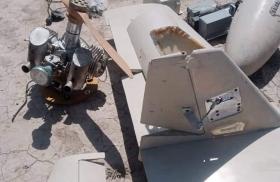
- Michael Knights
- Amir al-Kaabi
- Hamdi Malik
Regions & Countries
Stay up to date.

Iraqi militant group claims missile attack on Tel Aviv targets, source says
- Medium Text
Sign up here.
Reporting by Timour Azhari Editing by Chris Reese and Sandra Maler
Our Standards: The Thomson Reuters Trust Principles. New Tab , opens new tab
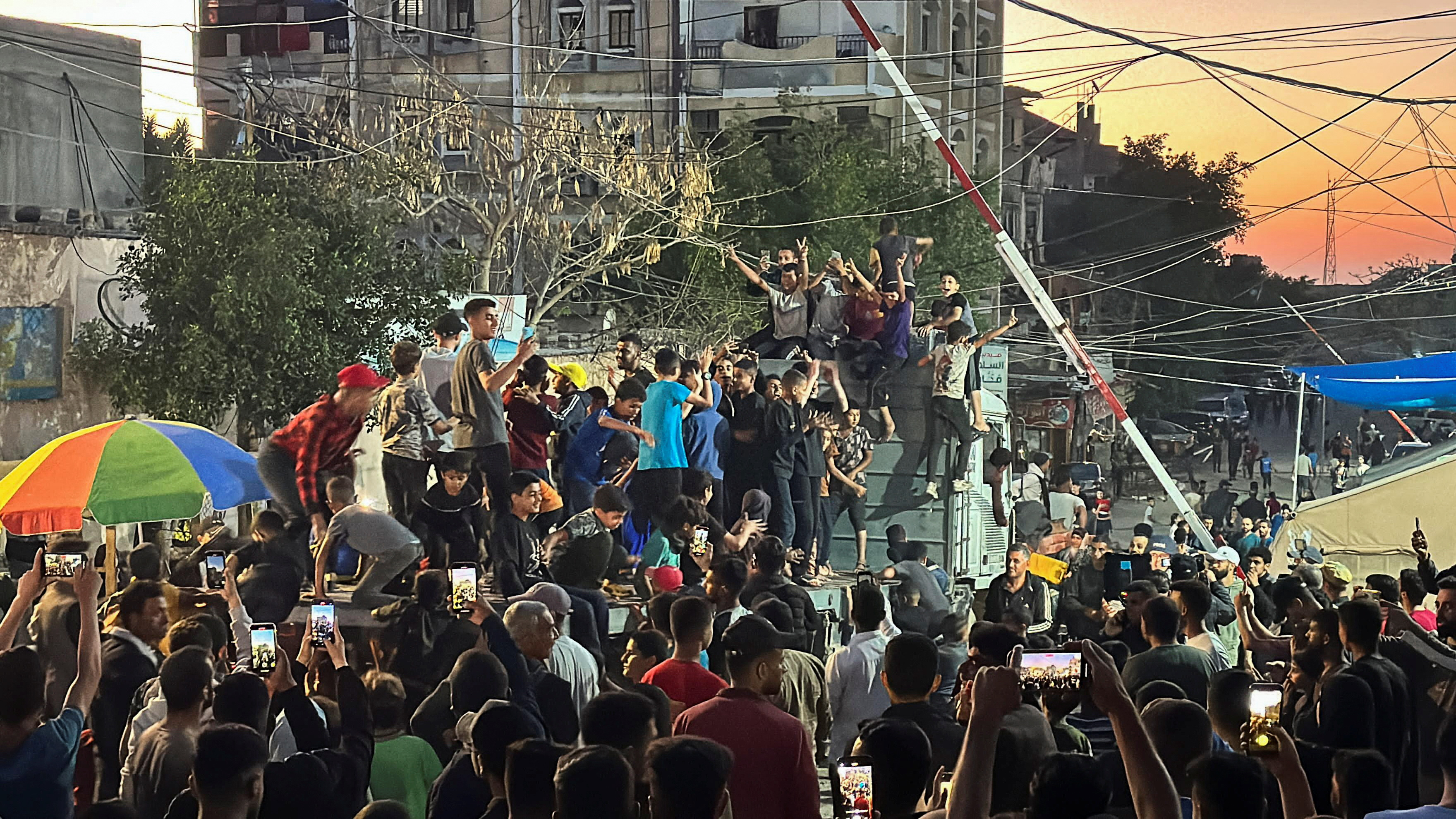
World Chevron
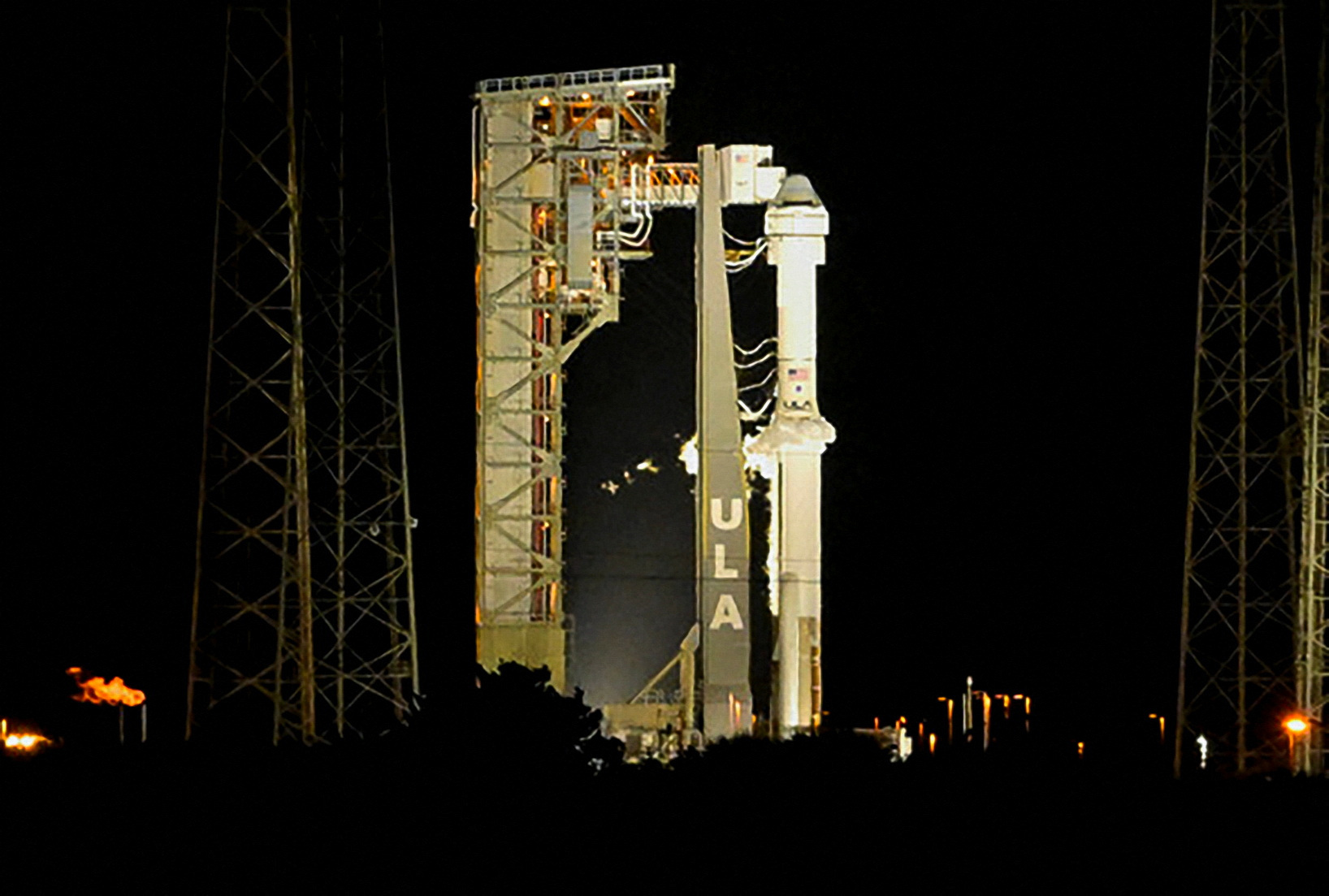
Boeing Starliner capsule's first crewed test flight postponed over Atlas rocket glitch
The long-awaited first crewed test flight of Boeing's Starliner spacecraft was called off for at least 24 hours over a technical glitch with the Atlas V rocket that was being readied to launch the new astronaut capsule to orbit on Monday night.
Australia's CSL , the world's largest producer of blood plasma products, is trialling "dynamic pricing" of payments to donors to grow profit margins amid persistently high supply costs, a senior executive said on Tuesday.
The U.S. issued visa restrictions against executives of several Colombia maritime companies allegedly linked to migrant transportation to the Colombia-Panama border, a senior U.S. official said on Monday on a call with reporters.

Iran-backed militias in Iraq claim to target Israel with cruise missiles
What Iran’s attack on Israel revealed about its weapons arsenal
Iran’s first direct attack on Israel overnight Saturday demonstrated the country’s military might and the advances of its domestic weapons program, analysts said, while also revealing the limitations of its arsenal.
With more than 300 drones and missiles launched in a layered onslaught, it was Iran’s largest-ever conventional show of force . That it inflicted only minimal damage was due in part to the choreographed nature of the attack — giving Israel and the United States ample time to prepare air defense systems — but may also be attributed to shortcomings in its medium- and long-range capabilities.
“The operation showed that our armed forces are ready,” Iranian president Ebrahim Raisi told crowds gathered Wednesday in Tehran to mark Army Day. Parades in the Iranian capital featured many of the same munitions used in the attack on Israel.

What Iran used against Israel
110 ballistic
Iranian drones
These drones can deliver small payloads of explosives in self-detonating attacks.
Length: 11.5 ft.
Width: 8 ft.
Max. take off weight: 440 lb.
Max. speed: 115 mph
Range: About 1,100 - 1,500 miles
Its nose contains a warhead and can be equipped with a camera.
Length: 8 ft.
Width: 7 ft.
Max. take off weight: 300 lb.
The Shahed-131 is an earlier version of Shahed-136 with a similar principle of operation. The layout and aerodynamics are also identical.
Ballistic missiles
KHEIBAR SHEKAN
The Kheibar Shekan MRBM is a solid-propellant ballistic missile designed by the IRGC.
Length: 34 ft.
Diameter: 2.6 ft.
Max. range: 900 miles
Warhead weight: 1,100 lb.
Introduction: 2022
The Emad MRBM is an Iranian-designed, liquid-fuel ballistic missile based on Shahab-3.
Length: 54 ft.
Diameter: 4.1 ft.
Max. range: 1,056 miles
Warhead weight: 1,650 lb.
Introduction: 2015
The Ghadr-1 MRBM seems to be an improved variant of the Shahab-3A. It is also referred to as the Ghadr-101 and the Ghadr-110.
Max. range: 1,211 miles
Warhead weight: 1,760 lb.
Introduction: 2007
Cruise missile
Max. range: 1,025 miles
Introduction: 2023
What Iran did not use
The Sejjil-1 Iranian MRBM is a two-stage, solid-propellant, surface-to-surface missile.
Length: 60 ft
Max. range: 1,243 miles
Warhead weight: 1,540 lb.
Introduction: 2011
The Shahab-3 is a MRBM developed by Iran and based on the North Korean Nodong-1.
Diameter: 4.1 or 4.5 ft.
Max. range: 808 miles
Warhead: Single or multiple
with 5 warheads of 617 lb.
Introduction: 2003
Sources: OE Data Integration Network (ODIN),
CSIS Missile Defense Project

120 ballistic

120 ballistic missiles
30 cruise missiles
Overhead view
1,211 miles
1,056 miles
Max. range:
Warhead weight:
Introduction:
Sources: OE Data Integration Network (ODIN), CSIS Missile Defense Project

Raisi hailed the attack as a resounding “success,” but was also quick to qualify the strikes as “limited” and “not comprehensive.”
“If it was supposed to be a large-scale action, nothing would have been left of the Zionist regime,” he said. And if Israel retaliates, Raisi pledged, “they will be dealt with fiercely and severely.”
Yet after analyzing the munitions used in Saturday’s assault and the success of regional defense systems, researchers say it’s unclear how Iran could inflict greater damage on Israel through conventional military means.
“Iran basically threw everything it had that could reach Israel’s territory,” said John Krzyzaniak, a researcher who studies Iran’s missile programs at the Wisconsin Project on Nuclear Arms Control. Like other analysts interviewed for this story, he has spent the past several days studying launch videos, imagery of debris and interception information to identify the Iranian munitions.
His conclusion is that Tehran “used some of every system they have.” And experts said it made sense that the Sejjil-1 and Shahab-3 missiles were excluded from the attack.
Shahab-3 “wasn’t used because it’s so old,” said Fabian Hinz, an Iran analyst at the International Institute for Strategic Studies in Berlin. “The Sejjil is a bit of a mysterious missile,” he said, adding that Iran has “used it very, very little during maneuvers.”
Other analysts noted the Sejjil was expensive to produce and may no longer be in production.
The quantity of munitions used also provides new insights into Iran’s capabilities. The deployment of over 100 ballistic missiles in a single wave suggests that previous estimates that Iran has about 3,000 ballistic missiles stockpiled are probably accurate, and could even be on the low end.
“If this is just round one of an unknown number of rounds to come, you wouldn’t fire a significant fraction of what you have just in the first round,” Krzyzaniak said.
The firing of over 100 ballistic missiles in the space of a few minutes suggests Iran has at least 100 launchers, he added — a new data point for researchers.
“This shows that Iran has really faced no limitation in domestically producing missiles and launchers,” he said.
Iran’s ballistic missile arsenal, the largest of any country in the Middle East, is almost entirely homegrown. In recent years Iran has demonstrated the ability to upgrade some systems, improving their range and precision.
The spokesman for Iran’s armed forces, Abolfazl Shekarchi, said the munitions used in the strikes against Israel only represented “a fraction of” the country’s military’s might, according to a statement published on state-run media.

The evolution of Iran’s
missile program
In the mid-1980s, Tehran acquired Scud missiles from Libya, Syria and North Korea and also began adapting the technology for their own missile variants. During the eight-year war with Iraq, Tehran countered primarily with Scud B missiles, which have a range of 185 miles.
Shahab-1 , 186 miles
1994 to 2001
Iran developed its own version of the Scud B, the Shahab-1, and from 1994 to 2001 fired it at bases in Iraq used by the opposition group Mujahedin-e Khalq.
A new generation of missiles
After 16 years without firing new missiles, Iran showed its technological advances in 2017 striking on an ISIS command center with 6 Zolfaghars with a range of 430 miles. In early 2024, it launched strikes against Islamic State targets in northwest Syria using Kheibar Shekan missiles that travelled 745 miles from Iran to Syria.
Fahteh 110 , 181 miles
Fahteh 313 , 310 miles
Zolfaghar , 435 miles
Qiam 1 , 497 miles
Kheibar Shekan , 900 miles
IRAN ATTACKS
Against ISIS
6 ballistic missiles
Deir ez-Zor, Syria
Against Kurdish dissidents
7 ballistic missiles
Abu Kamal, Syria
Against Oil fields and facilities
18 drones + 7 cruise missiles
Abqaiq, S. Arabia
Khurais, S. Arabia
3 cruise missiles
Against U.S. forces
Erbil, Iraq
1 ballistic missile
Ain Al Asad, Iraq
15 to 22 ballistic missiles
Against “Israeli strategic centers”
At least 10 ballistic missiles
73 launches + at least 20 drones
and suicide drones
Sulaimaniyah,
Against IS targets
Harem, Syria
Israeli “spy headquarters”
Against Jaish ul Adl
Balochistan,
Missiles and drones
Against Israel
120 ballistic missiles,
170 drones,
Sources: United States Institute of Peace, CSIS, IDF

The evolution of Iran’s missile program
IRAN TARGETS
KNOWN MISSILE
Zolfaghars,
Abqaiq, Saudi Arabia
Khurais, Saudi Arabia
Zolfaghars and
potentially
Ballistic missiles and suicide drones
Sulaimaniyah, Iraq
Kheibar Shekan
Balochistan, Pakistan
Missiles and drones against Jaish ul Adl
170 drones, 30 cruise missiles
Before the attack on Israel, Iran’s most significant use of ballistic missiles was in 2020, after a U.S. drone attack killed the powerful Iranian commander Qasem Soleimani.
Iran launched more than a dozen ballistic missiles at two U.S. military bases in Iraq, one in the country’s west and one in the north. While there were no fatalities, dozens of U.S. service members suffered traumatic brain injuries.
Iran also used ballistic missiles in strikes this year on Pakistan, Syria and Iraq.
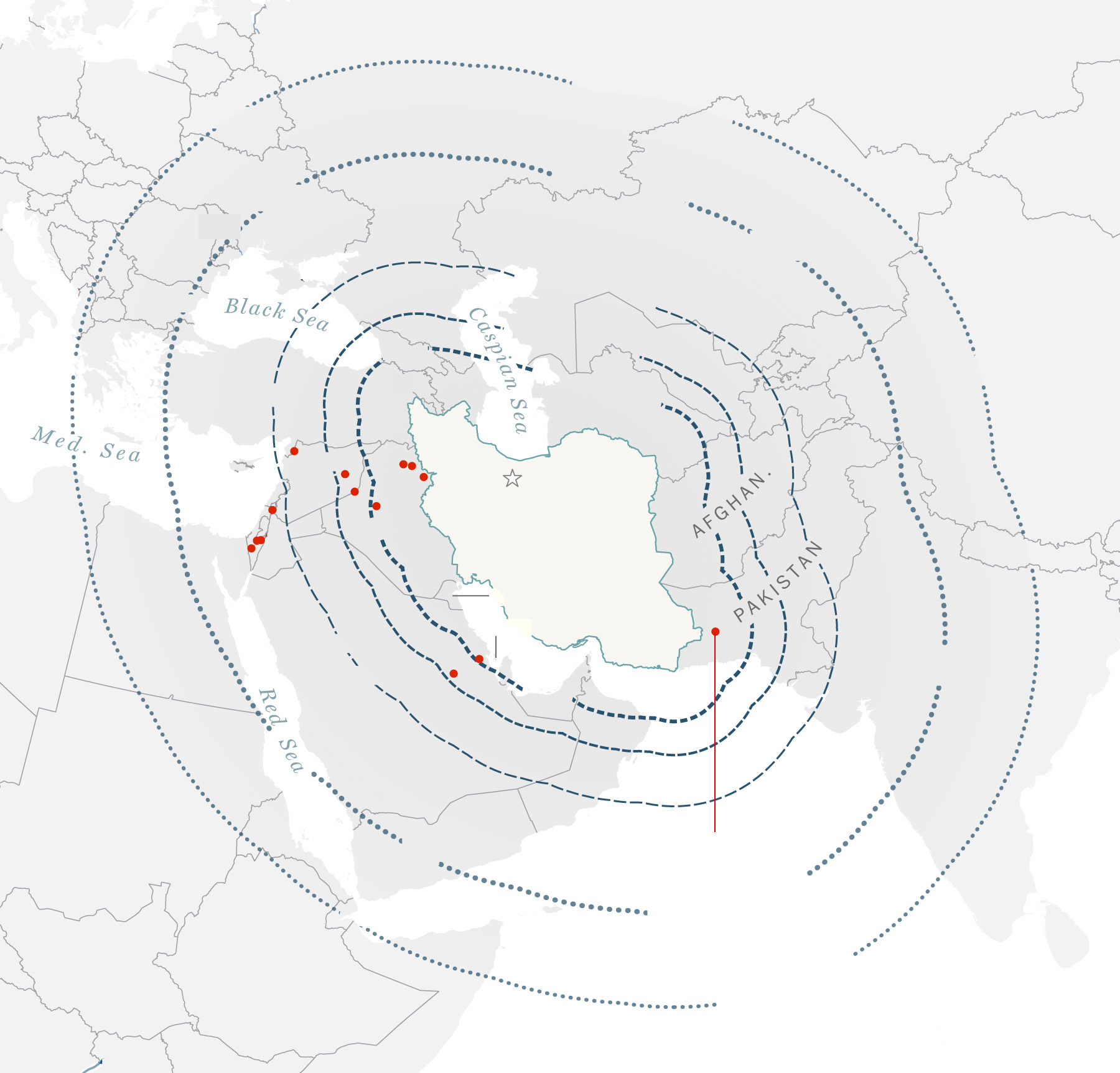
Iranian ballistic
missile ranges
1,240 miles
Locations of Iranian
missile strikes
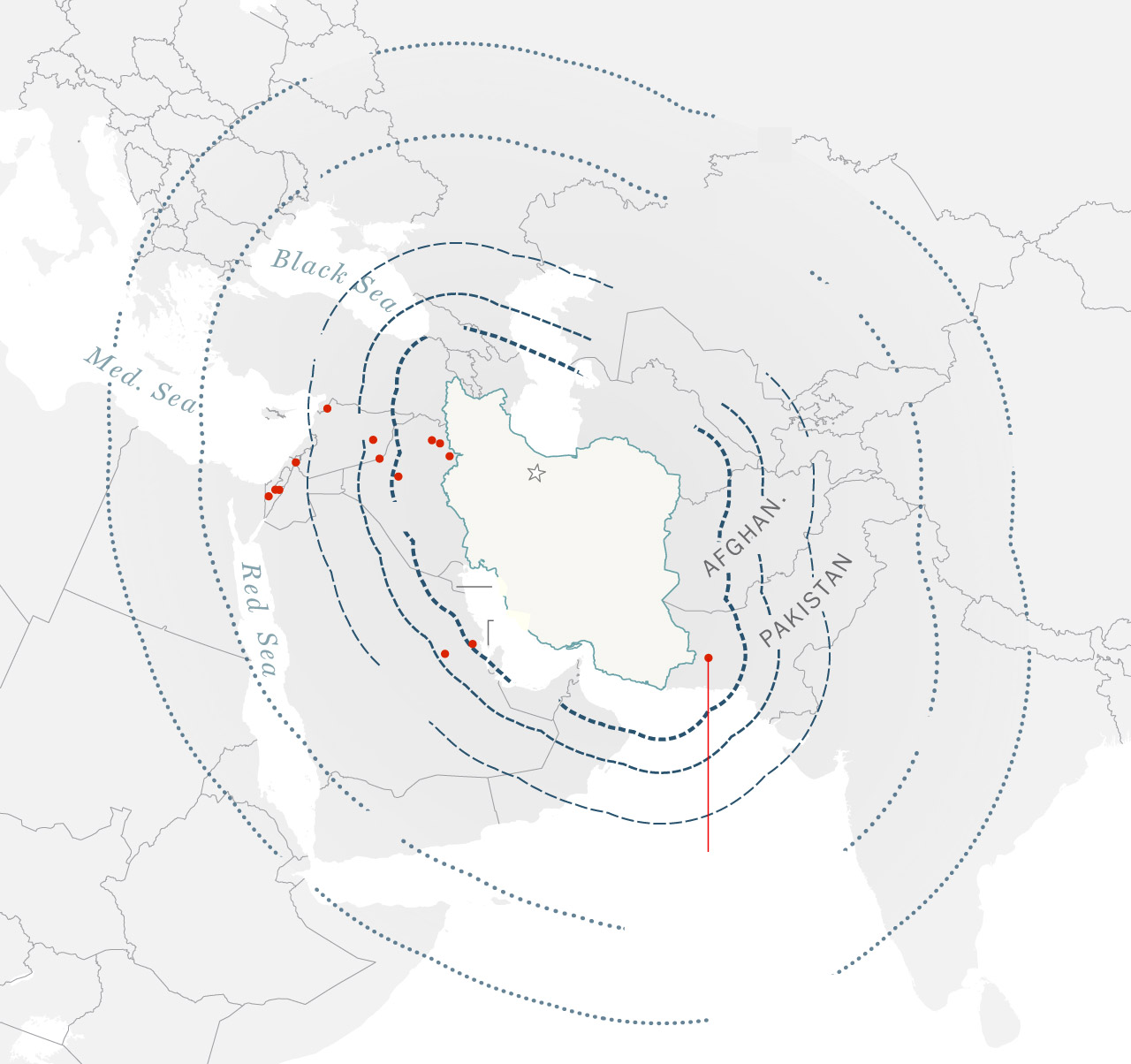
INDIAN OCEAN

But the attack on Israel suggests that many of Iran’s munitions are of low quality. Israel’s military said 99 percent of the missiles and drones launched by Iran were intercepted or failed to launch.
“We saw that accuracy and precision are a work in progress,” said Behnam Ben Taleblu, a senior fellow at the Foundation for Defense of Democracies who has written extensively about Iran’s missile program. “These weapons alone won’t win a war for Iran.”
Iranian drones made up the first wave of the attack. Cheap, effective and easy to produce, Iranian drones have been used in attacks across the Middle East for years. Iran has also supplied drones to Russia for its war in Ukraine , where they have been deadly.
During the attack on Israel, the slow-moving drones were probably deployed to occupy air defenses and allow more advanced munitions to get through. All the drones were shot down before entering Israeli airspace, the Israel Defense Forces said.
Ali Hamie, a Lebanese military analyst, said Iran had probably gleaned important lessons about Israel’s aerial defenses. Commentators on Iranian state television have made similar points.
“It could be a testing attack,” Hamie said, “and the Iranians got what they want. Making it past the air defenses is not only a symbolic victory, but real victory.”
One of the few missiles to make it through the interceptors hit an Israeli air base in the Negev desert. Images of the strike were run on loop on many state-run Iranian broadcasters in the days after the attack. Israel characterized the damage as minor.
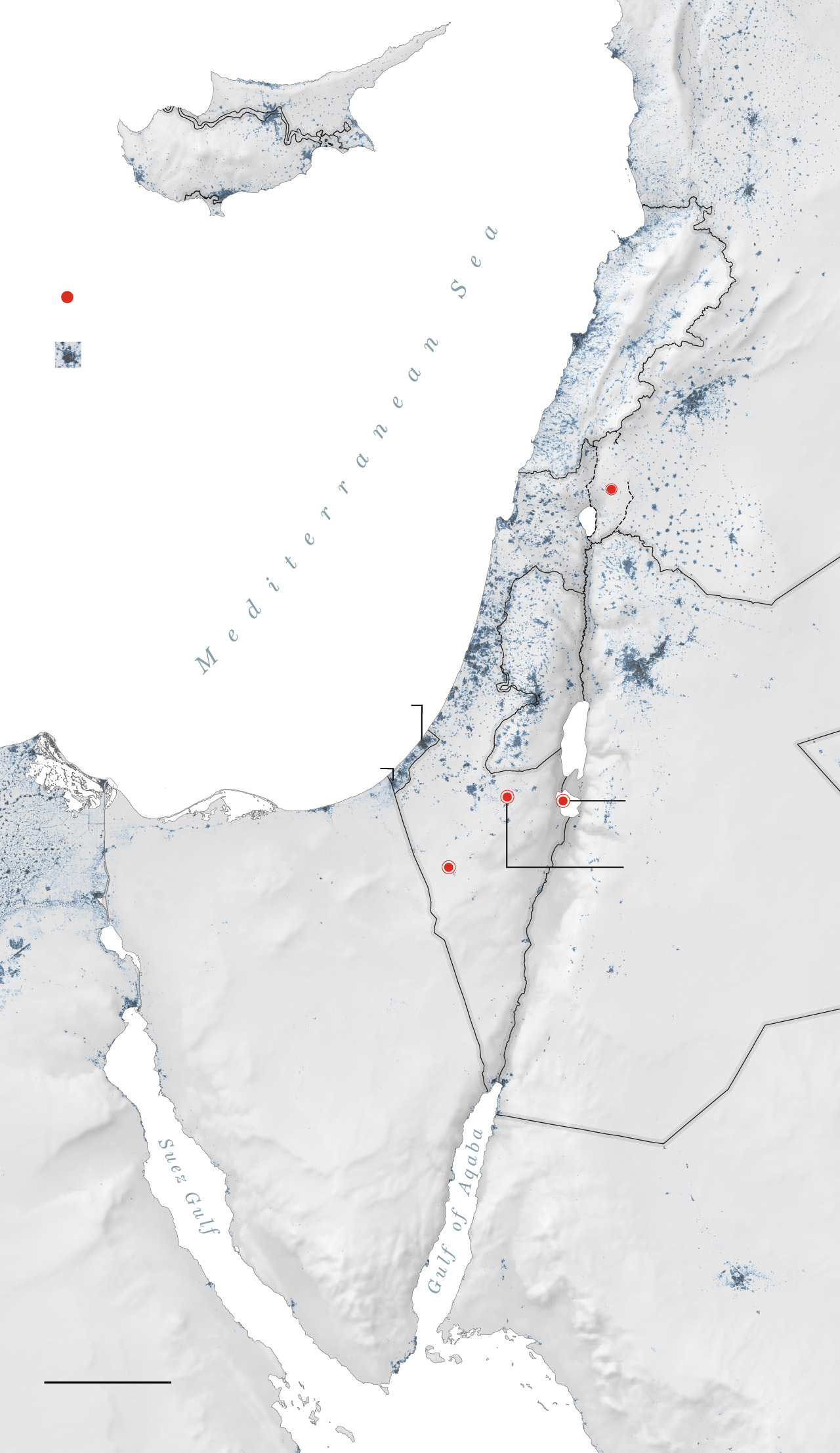
General location of missile strikes
that reached the ground.
Beirut—
Populated areas
Haifa—
Tel Aviv—
—Amman
—Jerusalem
An emad missile
was found here.
The barrage of
missiles from Iran
included targeting
the Nevatim

General location of
missile strikes that
reached the ground.
Mediterranean

General location of missile
strikes that reached the
In addition to analyzing Israel’s air defenses, Tehran will probably also be studying the problems with its missile systems that reportedly led to failures at launch and in flight, according to Afshon Ostovar, a professor of national security affairs at the Naval Postgraduate School in California.
“Another attack could be more effective,” he said. But ultimately the kind of approach demonstrated in Saturday’s attack “is not really sustainable over a long-term conflict.”
Even if Iran changed the tempo of attacks and adjusted the munitions used, “they would still have to launch quite a lot of stuff for just a few [munitions] to get through,” he said.
Some Iranian officials have suggested they have held back their most dangerous weapons.
“We are prepared to use weapons we have never used before. We have plans for every scenario,” said Abolfazl Amoui, a parliamentary national security spokesman, in an interview with Lebanese broadcaster Mayadeen.
But analysts say it’s unlikely that any one type of munition could be a game changer. Rather, it’s more likely Iran would use the same kinds of munitions in a future attack, but in a different way: giving less warning, or launching the barrage in concert with allied militant groups in the region. The country’s proxy forces, from Lebanon to Iraq to Yemen, played little role in Saturday’s assault.
As Israel mulls its response , Tehran has warned that a counterattack would come in “a matter of seconds.”
“Iran will not wait for another 12 days to respond,” Deputy Foreign Minister Ali Bagheri Kani said Monday.
While the United States and Israel have celebrated the thwarting of Saturday’s attack, analysts are urging humility.
“The number of munitions it took to repel the attack was enormous, costly and could be difficult to replicate,” said Tom Karako, the director of the Missile Defense Project at the Center for Strategic and International Studies.
“Israel may have gotten lucky and Iran may have gotten very unlucky.”
William Neff and Suzan Haidamous contributed to this report.
Israel-Gaza war
The Israel-Gaza war has gone on for six months, and tensions have spilled into the surrounding region .
The war: On Oct. 7, Hamas militants launched an unprecedented cross-border attack on Israel that included the taking of civilian hostages at a music festival . (See photos and videos of how the deadly assault unfolded ). Israel declared war on Hamas in response, launching a ground invasion that fueled the biggest displacement in the region since Israel’s creation in 1948 .
Gaza crisis: In the Gaza Strip, Israel has waged one of this century’s most destructive wars , killing tens of thousands and plunging at least half of the population into “ famine-like conditions. ” For months, Israel has resisted pressure from Western allies to allow more humanitarian aid into the enclave .
U.S. involvement: Despite tensions between Israeli Prime Minister Benjamin Netanyahu and some U.S. politicians , including President Biden, the United States supports Israel with weapons , funds aid packages , and has vetoed or abstained from the United Nations’ cease-fire resolutions.
History: The roots of the Israeli-Palestinian conflict and mistrust are deep and complex, predating the establishment of the state of Israel in 1948 . Read more on the history of the Gaza Strip .
- Six months of the Israel-Gaza war: A timeline of key moments April 7, 2024 Six months of the Israel-Gaza war: A timeline of key moments April 7, 2024
- Colombia is the latest and largest country to sever ties with Israel May 1, 2024 Colombia is the latest and largest country to sever ties with Israel May 1, 2024
- Hamas touts ‘positive spirit’ in cease-fire talks, will travel to Cairo May 2, 2024 Hamas touts ‘positive spirit’ in cease-fire talks, will travel to Cairo May 2, 2024

Rocket attack from Iraq targets US base in Syria
The attack was the first by Iranian-backed groups against US troops in Iraq since they halted a campaign in early February.
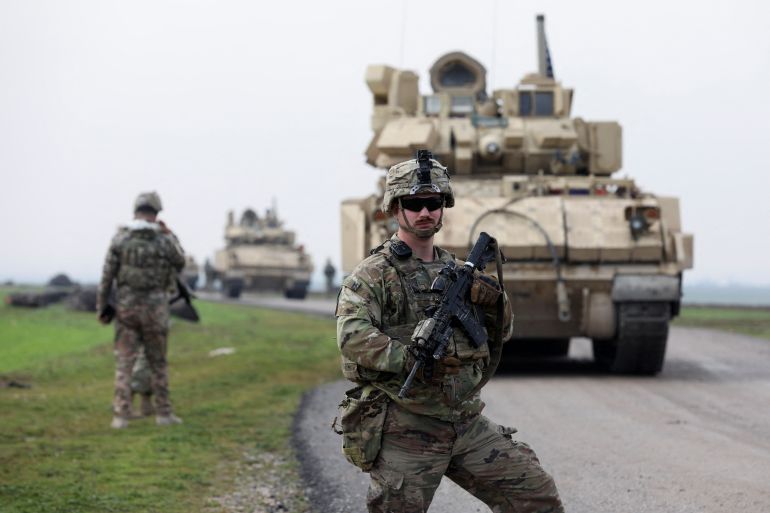
Several rockets have been fired from Iraq towards a US military base in northeastern Syria.
The attack, launched from the town of Zummar late on Sunday, was the first since early February to target US troops, when Iranian-backed groups in Iraq brought to an end a campaign that had seen regular strikes against the US-led international coalition.
Keep reading
Photos: distinctive ramadan rituals in mosul, northern iraq, northern iraq hit by iranian missile strikes, are the americans ready for another iraq.
The resumed hostilities came a day after Iraqi Prime Minister Mohammed Shia al-Sudani returned from a visit to the United States where he met with President Joe Biden.
A post on a Telegram group affiliated with Kataib Hezbollah said armed factions in Iraq had decided to resume attacks after a near-three month pause having seen little progress on talks to end the US-led military coalition in the country.
However, on Monday, Kataib Hezbollah said it had issued no statement claiming a return to attacks on US forces. It called the earlier announcement “fabricated news”.
A statement from the Iraqi security forces accused “outlaw elements of having targeted a base of the international coalition with rockets in the heart of Syrian territory”, at about 9:50pm (18:50 GMT).
Iraqi forces launched a major search operation in northern Nineveh province and found the vehicle used in the attack, the statement added.
‘Failed attack’
A US official, speaking on the condition of anonymity, told the Reuters news agency more than five rockets were fired from Iraq towards troops at a coalition base in Rmeilan, Syria, but no US personnel were injured.
The official referred to it as a “failed rocket attack”, but it was not immediately clear if the rockets had failed to hit the base or been destroyed before they reached. It was also not clear if the base was the target itself.
Following that, the official said, an aircraft from the US-led coalition in Iraq and Syria carried out a strike against the launch site.
Two security sources and a senior army officer in Iraq said a small truck with a rocket launcher fixed on the back had been parked in Zummar, a town on the border with Syria.
An army officer said the truck was destroyed and seized for further investigation.
“We are communicating with the coalition forces in Iraq to share information on this attack,” the officer added.
The targeting of US forces in the region intensified after the war in Gaza began on October 7.
In January, three US service members were killed and at least 34 others wounded in a drone attack in northeast Jordan near the Syrian border.

Enduring aggression: Iran's proxy militias' relentless offensive
I ran’s proxy groups in the region continue to claim they are carrying out attacks on Israel. The claims come amid ongoing talks of a ceasefire . This is important because it reveals how Iran seeks to use the lead-up to any kind of agreement to solidify its advantage in the region.
Iran has exponentially increased the role of its proxies in recent years, expanding them in Iraq and Syria and aiding the Houthis to increase the range of their drones and missiles.
After the Hamas attack on October 7, Iran pushed each militia to begin attacks in a slowly increasing set of strikes from multiple fronts. This includes Hezbollah, the Houthis, and militias in Iraq and Syria .
Some attacks do not reach Israel
Most recently, pro-Iran media said that an Iranian-backed terrorist group in Bahrain had also carried out two attacks. Most of these attacks consist of “claims,” not necessarily evidence they ever reached Israel. This is because the long-range low-tech drones being used by these groups are notoriously ineffective and prone to breakdowns along the flight path.
Nevertheless, the latest claim was on May 5, when “according to the Al-Mayadeen news network, the Islamic Resistance in Iraq announced Sunday that it had launched a cruise missile at the Haifa Port.”
The report said that “the cruise missile, the Arqab, was launched from Iraqi soil toward the occupied Palestinian territories. The Iraqi resistance said that the operation was carried out to support the Palestinian cause amid the ongoing war in the Gaza Strip.”
The claim that an Iraqi group has continued its attacks on Israel appears to be designed to show that every day, Iran can claim one of its many proxies is continuing to threaten Israel from a different front. The operationalization of a group in Bahrain was designed to do that.
However, it is unclear if these groups are actually able to strike at Israel or if they are merely being told to make claims so that it seems Iran is continuing its full-court press on Israel.
Clearly, Iranian media, such as IRNA in Iraq, and pro-Iran media, such as Al-Mayadeen, seek to highlight a number of attacks daily. Some of these are real, such as the Hezbollah threats, but others appear more to be propaganda than actual incidents.
That doesn’t mean the threats from Iran’s militias in Iraq or Syria are not emerging, growing threats. They are threats, and they must be taken seriously. However, it’s important to understand the context of this Iranian pressure campaign on Israel in which it has inflamed a number of fronts or "arenas” against Israel.

U.S. Military Is Using Laser Weapons In Battle
Prototype laser air defense systems deployed by the U.S. Army have taken out enemy drones in the Middle East, an Army official told Forbes.
- Share to Facebook
- Share to Twitter
- Share to Linkedin
BlueHalo's Locust laser air defense system, which is designed to shoot down small drones, rockets and mortar shells.
T he United States military has invested tens of billions of dollars over a half-century in the research and development of directed energy weapons. Now, it’s actually using them in battle.
The Army has used lasers to take down hostile drones in the Middle East, Doug Bush, the Army’s head of acquisitions, recently told Forbes . It’s the first time the Defense Department has acknowledged that such weapons have been used in combat.
“They've worked in some cases,” Bush said. “In the right conditions they're highly effective against certain threats.”
He declined to detail the weapons used, but one appears to be a system called P-HEL. It’s based on the defense contractor BlueHalo’s Locust laser, a boxy pallet-mounted device for fixed-site defense that’s commanded with an Xbox gaming controller. The weapon is designed to discharge a relatively low-powered 20-kilowatt laser beam that melts a critical point on a drone in seconds, knocking it from the sky.
In November 2022, the Army began using the first P-HEL overseas, with a second unit deployed this year, according to BlueHalo , making it the first “major laser weapon system” to be operationally deployed, CEO Jonathan Moneymaker told Forbes . But it has never before confirmed its use in battle.
Moneymaker said Locust has had a “significant” number of successful engagements in which it has burned drones out of the sky. “Not in the onesies, twosies,” he said.
It’s a milestone for the Pentagon, which is wrangling the costs of unmanned aerial combat, where the price of defense often far exceeds that of offense. U.S. air defense missiles cost roughly twice as much as offensive missiles, and the disparity is even worse with the cheap drones that have proliferated in the Middle East and in the Russia-Ukraine war. In the Red Sea, U.S. warships defending cargo vessels from attacks by Yemen’s Houthi militants over the past six months have used $2 million missiles to shoot down $2,000 drones.
So-called directed energy weapons like lasers and high-powered microwave systems, which use electromagnetic radiation to fry the electric components of their targets, are vastly cheaper. Their cost per shot ranges between $1 to $10 for the diesel fuel needed to generate the electricity that powers them, according to a 2023 GAO report.
Another benefit of laser weapons: stealth. The beams are usually invisible and silent. Advocates of an effort to test a laser on an Air Force special operations AC-130 gunship touted the prospect of being able to disable vehicle engines and communications equipment without an enemy knowing. (The program was canceled this spring after years of delays.)
Small drones are an easier target for the nascent technology compared to missiles and manned warplanes since they’re relatively slow and fly at low altitudes.
But laser weapon systems are expensive to build. The first P-HEL prototypes cost $8 million apiece, the Army told Forbes ; prototypes of a vehicle-mounted system with a more powerful 50-KW laser called DE M-SHORAD have cost $73 million. That’s a pricey investment given the many expensive modernization programs competing for the Pentagon’s $825 billion budget.
“It's really tough for the Army to afford a directed energy system that costs as much as an F-35,” said Bush, who hopes prices will drop to a fourth of the stealth fighter jet’s average $82.5 million price tag.
The current generation of laser prototypes also face questions about their effectiveness. Lasers are hampered by sandstorms, rain, fog and smoke. Even on a clear day, air turbulence can defocus and weaken them. And they need to remain focused on a point on a target for several seconds, raising questions over whether a single laser can deal with swarms of drones.
But advocates say laser counter-drone systems don’t have to work in all conditions to be worthwhile.
Bad weather also degrades the effectiveness of the weapons that they’re meant to counter, notes Thomas Karr, who was the inaugural director of a Pentagon office set up to coordinate directed energy research from 2018 to 2020. “The incoming drone isn't going to fly very well in a sandstorm either.”
Bush said lasers would just be one part of a multi-layered counter-UAS system including kinetic interceptors like missiles or RTX’s Coyote kamikaze drone ($120,000 a pop) and gun-based weapons like C-RAM.
“If it saved 10% to 20% of the interceptors we would have to otherwise fire, that's still a very good return on investment,” he said.
Star Wars Dreams
The promise of directed energy weapons has enticed the Pentagon since the 1960s, but it was thwarted for decades in part by overambitious projects like the Reagan-era Space Defense Initiative. Derided as Star Wars, until its cancelation in 1993, roughly $30 billion was spent to develop a system that included space-based lasers to blow up fast-moving Soviet ballistic missiles from thousands of miles away.
Another prominent failed attempt to blast ICBMs: the $5 billion Airborne Laser program, billed as America’s first lightsaber, which was wound down in 2012. Researchers struggled with size and weight problems in mounting a megawatt-class laser powered by bulky containers of hazardous chemicals on a 747 airliner.
By 2010, research had refocused on the much less ambitious goal of hitting smaller targets like artillery shells and the emerging threat of slow-moving drones from just a couple of miles away or less.
“The technology does not have to perform at this very stressing level and you don't need as much power, you don't need as much accuracy,” said Karr.
The Pentagon has been spending roughly a billion dollars a year on directed energy research since 2020, according to a GAO report.
“In the low 20s” number of systems have been deployed with military units for field testing and are available for commanders to use, said Frank Peterkin, the DoD’s principal director for directed energy.
That includes four DE M-SHORADs, which feature a laser made by RTX mounted on a Stryker armored troop carrier. They were deployed to Iraq this spring for field testing. (One focus is on how well the lasers stand up to the shock and vibration as they’re moved around.)
Members of the 60th Air Defense Artillery Regiment pose with Stryker armored vehicles outfitted with 50-KW lasers at Fort Sill, Oklahoma, after the prototype systems were delivered in September.
Since 2019 the Navy has installed a low-powered laser “dazzler” called ODIN on eight destroyers; it’s designed to disrupt the optical or infrared sensors on enemy drones. In 2022 the Navy fielded a 60-KW laser made by Lockheed Martin Lockheed Martin called HELIOS on another destroyer, the Preble, that’s capable of destroying drones and outboard motors on small boats.
But these weapons have been notably absent from the fighting in the Red Sea, where they could be effective against some Houthi weapons, Vice Admiral Brendan McLane, the head of naval surface forces, said in January . He called the slow pace of progress in fielding laser weapons “frustrating.”
High-powered microwave weapons aren’t hampered by weather, but they tend to have a shorter range. The Southern California startup Epirus has delivered four prototypes of its Leonidas system to the Army under a $66 million contract. Epirus CEO Any Lowery told Forbes it can throw up “a wall” of energy hundreds of yards out from a base’s perimeter to take down multiple drones simultaneously, functioning as the last line in a layered air defense, like a “hockey goalie.”
It would take six of the systems to defend an average airfield, Lowery said. The four prototypes have cost $13 million apiece, Army said.
Lowery says Leonidas performed better than he expected in Army trials last month at the China Lake weapons range in California. They included tests of soldiers’ abilities to quickly repair the system, as well as defeating attacks by a range of drones.
Epirus' Leonidas high-powered microwave counter-UAS system.
Lowery is hopeful that Leonidas will advance soon to an overseas field deployment and that by 2027 Epirus could win the holy grail for weapons makers: transition to a “program of record” with a budget line for buying Leonidas units in large numbers.
That could track with the Army's timeline on directed energy weapons. Bush said the service is currently preparing budget plans for the 2026-30 timeframe in which they’re examining “how we could actually get to procurement on these things.”
Meanwhile, the DoD is funding work on more powerful lasers, including 300-KW systems from companies including Lockheed Martin, General Atomics and nLight that could take on larger, faster targets like cruise missiles. DoD directed energy czar Peterkin said the hope is that those will be ready for testing with field units within five years.
The U.S. is also investing in an intriguing Israeli effort. The military aid package for Israel that Congress passed last month includes $1.2 billion to fund development of Iron Beam. The 100-KW laser from Israeli defense contractor Rafael is designed to defeat rockets and drones. Israel hopes to field it by the end of next year, and the Pentagon could be interested in it as an alternative to the systems it’s developing, Bush told reporters last year.
If the Pentagon decides to field any of the current laser prototypes at scale, it could take a while for defense contractors to build up to mass manufacturing. Only a handful of companies make key components like optics, the Emerging Technologies Institute, a defense industry association think tank, warned in January . It faulted the Defense Department for having “wavered in its commitment” to the technology and failing to send a clear demand signal to industry to invest to get ready.
Bush said it’s more a question of limited congressional funding and multiple pressing priorities.
“Everything’s competing with everything else,” said Bush. “But what could move the dial is the threat is serious. And if we show that these systems can work against the current threats we're facing in the Middle East, it could move the conversation in the Pentagon.”

- Editorial Standards
- Reprints & Permissions

IMAGES
VIDEO
COMMENTS
Cruise missile attack on Baghdad. Pres. Clinton's Address on Iraq (1993) Between 1:00 am and 2:00 am local time on 26 June/June 27, 1993, 23 Tomahawk cruise missiles were launched by two U.S. Navy warships into downtown Baghdad. These hit a building which was believed to be the headquarters of the Iraqi Intelligence Service in the Mansour ...
Figure 1: Iranian-made Quds-2 cruise missile found and destroyed by explosive ordnance techs in Babil, Iraq, January 3, 2024. On January 3, Iraqi media outlets reported an explosion in Babil just south of Baghdad that was later clarified to be a controlled detonation. The item destroyed was a Quds-2 cruise missile (Figure 1) that appeared to have fallen off a transport or launch vehicle.
The Islamic Resistance in Iraq (IRI), a coalition of Iranian-backed groups, released a video on 8 January showing what it said was a long-range Al-Arqab cruise missile being launched at Haifa.
Operation Senior Surprise, also known as Secret Squirrel, was a long range B-52G Stratofortress cruise missile strike against Iraqi targets that initiated the bombing campaign during Desert Storm. ( It was given the unofficial nickname 'Operation Secret Squirrel' by the B-52 crews.) The mission took place from January 16, 1991, and ended January 17, 1991.
Outcome. United States victory. Targets damaged/destroyed. The 1996 cruise missile strikes on Iraq, codenamed Operation Desert Strike, were joint United States Navy - United States Air Force strikes conducted on 3 September against air defense targets in southern Iraq, in response to an Iraqi offensive in the Kurdish Civil War .
By Andrew Glass. 06/26/2009 05:05 AM EDT. On this day in 1993, President Bill Clinton ordered U.S. warships stationed in the Persian Gulf and in the Red Sea to launch Tomahawk cruise missiles ...
The military relied on unmanned Tomahawk cruise missiles in today's attack on Iraq because of the missile's accuracy and to avoid sending piloted aircraft near heavily defended Baghdad.
Navy ships and Air Force B-52 bombers fired a total of 27 cruise missiles at "selected air defense targets" in southern Iraq for about a 45-minute period beginning midmorning, the Pentagon told CNN.
The US military on Friday publicly thanked Iraq's police for their Jan. 3 discovery of a land-based cruise missile that a US official said was aimed at American troops in the country. For all ...
Iraq also operated two cruise missile programs from 1998 to 2002. The first program attempted to convert the HY-2 anti-ship cruise missile into a land-attack system, and to increase the missile's range from 100km to 150-180km. In one flight test, the missile reportedly reached a range of 168km, thus exceeding the 150km limit. [32] ...
A cruise missile launches from the USS Donald Cook in the Red Sea. • Egyptian President Hosni Mubarak said Iraq is fully responsible for the current crisis in the Middle East, the Kuwait News ...
A Tomahawk cruise missile launches from the forward vertical launch system of the USS Shiloh (CG 67) to attack selected air defense targets south of the 33rd parallel in Iraq on Sept. 3, 1996, as ...
Iran has developed a cruise missile with a range of 1,650 km (1,025 miles) a top Revolutionary Guards commander said on Friday, in a move likely to raise Western concerns after Russia's use of ...
In the case of Iraq/Syria strikes, this phrase has often coincided with the use of special weapons such as al-Aqsa 1 close-range ballistic missiles, antiaircraft missiles, or Quds-series cruise missiles. On two occasions—January 7 and 16—IRI claimed to use al-Arqab cruise missiles (part of the Quds series) against Israel (Figure 1).
In January 2021, false reports of penetration by American cruise missiles from several directions reportedly caused confusion within Iran's military command following its strike against al-Asad Air Base in Iraq—so much so that an IRGC TOR-M1 short-range air defense system shot down a Ukrainian civilian airliner near Tehran.
Referring to Iraq's use of cruise missiles, the chief-of-staff of the 32nd Army Air and Missile Defense Command told the New York Times "this was a glimpse of future threats. It is a poor man's air force. A thinking enemy will use uncommon means such as cruise missiles and unmanned aerial vehicles on multiple fronts." At least two reasons ...
May 3 (Reuters) - The Islamic Resistance in Iraq, a group of Iran-backed armed groups, launched multiple attacks on Israel using cruise missiles on Thursday, a source in the group said. The source ...
U.S. Strikes Iraq for Plot to Kill Bush By David Von Drehle and R. Jeffrey Smith Washington Post Staff Writers Sunday, June 27, 1993; Page A01. U.S. Navy ships launched 23 Tomahawk missiles ...
During the First Gulf War, coalition forces unleashed a massive assaults on Iraqi forces. At the heart of these attacks was a new weapon....the Tomahawk Miss...
Torpedo tubes. Surface ships. Submarines. TELs. The Tomahawk ( / ˈtɒməhɔːk /) Land Attack Missile ( TLAM) is a long-range, all-weather, jet-powered, subsonic cruise missile that is primarily used by the United States Navy and Royal Navy in ship and submarine-based land-attack operations. Developed at the Applied Physics Laboratory of Johns ...
The low-flying cruise missile was used again, in 1998, against Serb forces, and over 325 Tomahawks were launched against Iraq that same year in Operation Desert Fox. During the Iraq war in 2003, the number of Tomahawks used more than doubled compared to the first Gulf War, with over 725 of the cruise missiles launched at Iraq, according to ...
MAY 3, 2024 00:50. Iran-backed militias in Iraq claimed they launched cruise missiles toward Tel Aviv and Beersheba on Thursday afternoon in two statements published by the militias on Thursday ...
During the eight-year war with Iraq, Tehran countered primarily with Scud B missiles, which have a range of 185 miles. Shahab-1, 186 miles. Shahab-1. ... 170 drones, 30 cruise missiles.
A US official, speaking on the condition of anonymity, told the Reuters news agency more than five rockets were fired from Iraq towards troops at a coalition base in Rmeilan, Syria, but no US ...
Nevertheless, the latest claim was on May 5, when "according to the Al-Mayadeen news network, the Islamic Resistance in Iraq announced Sunday that it had launched a cruise missile at the Haifa ...
In the Red Sea, U.S. warships defending cargo vessels from attacks by Yemen's Houthi militants over the past six months have used $2 million missiles to shoot down $2,000 drones.
The Islamic Resistance in Iraq announced Sunday that it had launched Saturday a cruise missile at the Israeli Haifa port in occupied Palestine. The cruise missile, the Arqab, was launched from Iraqi soil toward the occupied Palestinian territories targeting the vital Haifa port, which had been attacked several times by the Resistance in light ...
On 13 April 2024, the Islamic Revolutionary Guards Corps (IRGC), a branch of the Iranian military, in collaboration with the Islamic Resistance in Iraq, Lebanese group Hezbollah, and the Yemeni Houthis, launched retaliatory attacks against Israel and the Israeli-occupied Golan Heights with drones, cruise missiles, and ballistic missiles. The attack was codenamed by Iran as Operation True ...